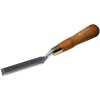What plane do you all recommend for smoothing glue ups? I am realizing that power tools and my Festool sander are very nice, but that doesn't mean they are the best way to go. I thought that many of you were over-romancing the hand tools, but after working with a card scraper i am now properly aware of how more efficient and effective they can be in the right situation..
I am either getting smarter, or older, or both...;-).
TIA,
Tim
I am either getting smarter, or older, or both...;-).
TIA,
Tim





